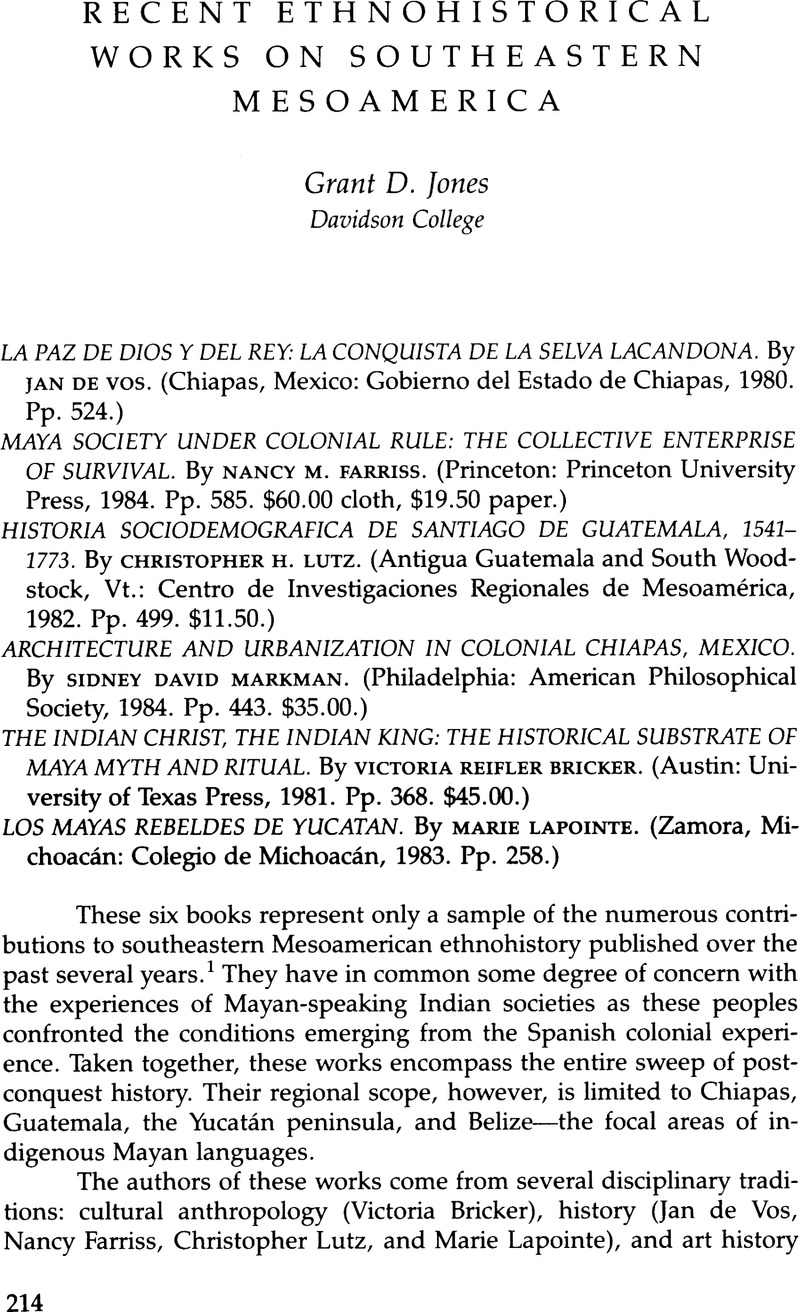No CrossRef data available.
Article contents
Recent Ethnohistorical Works on Southeastern Mesoamerica
Review products
Published online by Cambridge University Press: 12 October 2022
Abstract

- Type
- Review Essays
- Information
- Copyright
- Copyright © 1987 by the University of Texas Press
References
Notes
1. Other recent works pertaining to the ethnohistory of southeastern Mesoamerica include Peter Gerhard, The Southeast Frontier of New Spain (Princeton: Princeton University Press, 1979); William L. Sherman, Forced Native Labor in Sixteenth-Century Central America (Lincoln: University of Nebraska Press, 1979); Robert M. Carmack, The Quiché Mayas of Utatlán: The Evolution of a Highland Guatemala Kingdom (Norman: University of Oklahoma Press, 1981); Munro S. Edmonson, The Ancient Future of the Itzá: The Book of Chilam Balam of Tizimin (Austin: University of Texas Press, 1982); Spaniards and Indians in Southeastern Mesoamerica: Essays on the History of Ethnic Relations, edited by Murdo J. MacLeod and Robert Wasserstrom (Lincoln: University of Nebraska Press, 1983); Robert Wasserstom, Class and Society in Central Chiapas (Berkeley: University of California Press, 1983); and Sandra Orellana, The Tzutujil Mayas: Continuity and Change, 1250–1630 (Norman: University of Oklahoma Press, 1984). Murdo J. MacLeod's fundamental Spanish Central America: A Socio-Economic History, 1520–1720 (Berkeley and Los Angeles: University of California Press, 1973) was recently published in Spanish under the title Historia socio-económica de la América Central española (Guatemala City: Editorial Piedra Santa, 1980).
2. For another anthropological view on the structural analysis of history, see Marshall Sahlins, Historical Metaphors and Mythical Realities: Structure in the Early History of the Sandwich Islands Kingdom (Ann Arbor: University of Michigan Press, 1981), and his Islands of History (Chicago: University of Chicago Press, 1985). For another interesting perspective on the relationships between myth and colonial history, see Joanne Rappaport, “Myth, History, and the Dynamics of Territorial Maintenance in Tierradentro, Colombia,” American Ethnologist 12 (1985):27–45.
3. See also Kevin Gosner, “Soldiers of the Virgin: An Ethnohistorical Analysis of the Tzeltal Revolt of 1712 in Highland Chiapas,” Ph.D. diss., University of Pennsylvania, 1983.
4. Bricker was unaware of expedientes in the Archivo General de Indias pertaining to the Quisteil episode, reported by Nancy M. Farriss after the publication of Bricker's book (see Farriss, Maya Society under Colonial Rule, p. 429, n. 40).
5. For a contrasting interpretation of the Guerra de Santa Rosa, see Jan Rus, “Whose Caste War? Indians, Ladinos, and the ‘Caste War’,” in Spaniards and Indians in Southeastern Mesoamerica, pp. 127–68.
6. For bibliographic references to the Caste War of Yucatán, see Bricker, Indian Christ, Indian King, chap. 8.
7. Nelson Reed, The Caste War of Yucatan (Stanford: Stanford University Press, 1964).
8. Some of these frontier hostilities are discussed in Grant D. Jones, “The Last Maya Frontiers of Yucatán,” in Spaniards and Indians in Southeastern Mesoamerica, 64–91, and in “Maya-Spanish Relations in Sixteenth-Century Belize,” BELCAST Journal of Belizean Affairs 1 (1984):28–40.
9. Nicolás de Valenzuela: conquista del Lacandón y conquista del chol, 2 vols., edited by Götz Freiherr von Houwald (Berlin: Colloquium Verlag, 1979).
10. Both Bricker (p. 136) and de Vos (chap. 11) document examples of highland Maya carnival rituals in which historical encounters with the Lacandón appear to be recalled.
11. The best (although often flawed) published source on the Itzá conquest and its aftermath is Juan de Villagutierre Soto-Mayor's Historia de la conquista de la provincia de el Itzá, reducción y progresos de la de el Lacandón (Guatemala: Tipografía Nacional, 1933). Originally published in 1701, it was recently published in English as History of the Conquest of the Province of the Itzá (Culver City, Calif.: Labyrinthos, 1983).
12. France V. Scholes and Ralph L. Roys, The Maya Chontal Indians of Acalán-Tixchel: A Contribution to the History and Ethnography of the Yucatán Peninsula, 2d ed. (Norman: University of Oklahoma Press, 1968).
13. See, for example, Antonio C. Benavides and Antonio P. Andrews, Ecab: poblado y provincia del siglo XVI en Yucatán (Mexico City: Instituto Nacional de Antropología e Historia, 1979). Frontier mission churches are described archaeologically in David M. Pendergast, “Lamanai, Belize: An Updated View,” in The Lowland Maya Postclassic, edited by Arlen F. Chase and Prudence M. Rice (Austin: University of Texas Press, 1985), 91–103; and in the same volume, Elizabeth A. Graham, Grant D. Jones, and Robert R. Kautz, “Archaeology and Ethnohistory on a Spanish Colonial Frontier: An Interim Report on the Macal-Tipu Project in Western Belize,” 206–14.




